Eurybrachyid Planthoppers - Family Eurybrachyidae
This page contains pictures and information about Eurybrachyid Planthoppers that we found in the Brisbane area, Queensland, Australia.

Members in this family are medium in size with broad body. They have mottled forewings and coloured abdomen, usually brown, red, yellow or orange in colour. All of them have broad frons (front part of head).
They can be found resting on the main trunk of their host plants, usually Eucalyptus or Acacia. They are not noticeable because of their camouflaged colours. When we come close to them, they will walk to other spots, either up, down or sideway, and stop moving. If we come closer and try to touch them, they will jump with a 'tick' sound and fly away.

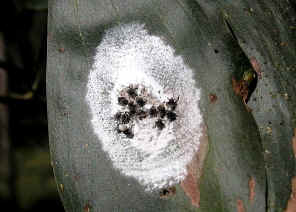
- Females lay eggs on tree trunks or leaves. The eggs are covered with a white waxy secretion produced by the ovipositing female. Nymphs are usually brown to dark brown in colour. Their habit are about the same as the adults. Like other members in the Hemiptera order, Planthoppers have their sucking mouth-parts to feed on host plants by sucking up the sap.
- The Australian Eurybrachyidae are quite distinctive from the world fauna. All Australian species belong to the subfamily Platybrachyinae, Tribe Platybrachyini.
Genus Platybrachys
We found quite a number of different Platybrachys Genus in Brisbane. They are usually found on the main trunk of trees of the Eucalyptus or Acacia. They are found resting, walking up, down or sideways around the tree trunks. The nymphs can also be found on the same tree.
- Planthopper

- Platybrachys sanguiflua, body length 15mm
- This planthopper was found resting on a wattle tree trunk. Its forewings covered the whole body, Wings and head resemble the colour and texture of the tree skin. However, it abdomen is pinkish-red in colour.
- Green Face Gum Hopper


- Platybrachys decemmacula, body length 20mm
- This planthopper can be found on gum tree truck, leaf and stem. They are common in the Eucalyptus forest in Brisbane. Their broad frons (front part of head) is pale green in colour. More pictures and information can be found in here.
- White-marked Gum Hopper


- Platybrachys leucostigma, adult body length 20mm, nymph body length 10mm
- The adult and nymph pictures are taken on the same gum tree trunk early summer. This species is somewhat variable in colour. Please click here for more pictures and information.
- Eye-patterned Gum Hopper


- Platybrachys vidua, body length 15mm
- This planthopper rests on tree trunk heading downwards. When moves, it moves backwards. Together with the eye-patterns on it forewing tips, it gives the impression of its tail is its head. It looked lager. We found many of them on gum tree trunk in Alexandra Hill during later summer. More information and pictures can be found in this page.
- Planthopper nymph

- Platybrachys sp., body length 10mm, not include tails.
- Dr. Murray Fletcher sent us email and advised this could be a Platybrachys sp. nymph.
- Spider-face Wattle Hopper
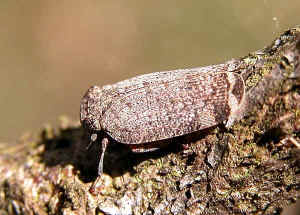

- Gelastopsis insignis, body length adult 9mm, nymph 6mm
- This planthopper is a bit smaller than the Platybrachys. They are brown in colour with red abdomen. The brown colours vary from pale brown to dark brown amount individual. The patterns on wings are about the same. There is the eyes-pattern on the front part of their head (frons) mimicking Jumping Spider. More information and pictures please visit this page.
- Green Face Wattle Hopper


- Olonia viridiventris, body length adult 11mm, nymph 7mm
- The planthoppers were found on wattle and have a bright green frons and pale green abdomen. More pictures and information please click on here.
- Wattle Hopper with white markings on wings


- Maon sinuatus, body length adult 10mm
- We found one planthoppers had the white marking on each wing. It was found on an Acacia tree.
- Dardus Wattle Hopper


- Dardus sp., body length 5mm
- This Leafhopper is dark brown in colour. Their antenna base is thicken and look like small horn under each eye. Some black ants were constantly visit them for their extracted honey-dew. The nymph also has this two little horns under eyes and with two long tails. They are found on young Black Wattle during late winter in Alexandra Hill. Nymphs and adults can be found on the same plants. More pictures and information please click on here.
Other Genus
- Planthopper 1st Instars


- Body length 3mm
- They are found on the bottom side of a Acacia leaf during late summer in Alexandra Hill.
- Hopper Egg-plate on tree trunk


- The black dot was a small parasite wasp, about 2mm in body length. This indicated that the eggs are infected of the wasp parasite.


- From the above second picture, we can tell that there were four parasite wasps hatched from the Planthopper egg-plate. There were four egg- shells with circle opening, which are the typical bite mark of parasite wasps. The wasps cut their way out using their mouth and made the round opening exit. The egg-shells with the narrow broken mark were those not infected.

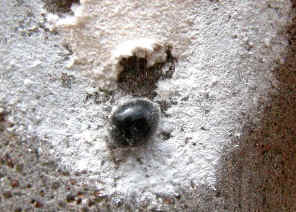
- In above pictures, at the lower side of the egg-plate, there is a beetle feeding on the eggs.
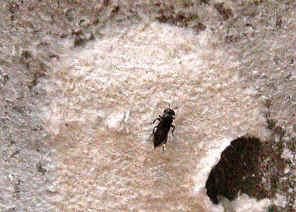
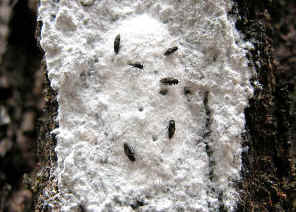
- At the upper side, there is a parasite wasp.
- Hopper Egg-plate on Wattle leaf
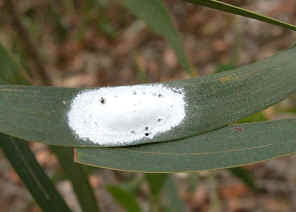

- We sometimes found those hopper egg-plate on wattle leaves. They are also suffering the wasp parasite.

- If a round cut hole indicated the egg has been infected by parasite wasp, most of the hopper eggs in the above picture were infected.
- We would like to thank Jerôme Constant in Belgium for his kindly email advices on identifying species in this Eurybrachyidae page. The world fauna is currently being reviewed by Jerôme Constant.
- Reference and Link:
- 1. Insects
of Australia, CSIRO, Division of Entomology, Melbourne University
Press, 2nd Edition 1991, pp 479.
- 2. Family Eurybrachyidae - Fletcher, M.J. and Larivière, M.-C. (2001 and updates).
- 3. Maon sinuatus - Fletcher, M.J. and Larivière, M.-C. (2001 and updates).
